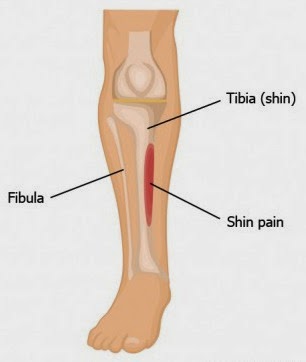Anyone can get shin splints but they are most common among runners, hikers, dancers and those who enjoy hobbies that require a lot of strenuous leg activity.
The proper name for shin splints is medial tibial stress syndrome referring to pain or inflammation in the shinbone (tibia) or lower leg. This pain is a result of the stress that placed on the bone as a result of the stress from the muscles attached to the bone, in this case, the tibia. The bone has an outer layer of tissue called the periosteum. The muscles are anchored to the bone via the periosteum and when they become tight, they begin to pull the periosteum off the bone which causes the intense pain where they are attached. If not treated early, shin splints can become Stress Reactions or, in more severe cases, Stress Fractures.
The most common causes are:
- Overuse – Repetitive actions place stress on legs. Over time scar tissue and adhesions develop causing muscles to tighten and weaken. Continued use of these weak and tight muscles lead to pain and inflammation.
- Muscle imbalances – Your body relies heavily on a few specific muscles that can become so strong that they overpower lesser-worked areas like certain muscles in your shins and quads.
- Flexibility imbalances – We all have a dominant leg just as most of us have a dominant hand. When one leg is more flexible than the other, it means you’re overusing it, putting extra stress on that leg’s muscles, joints, and the soft tissues surrounding them.
- Stress fractures – You may have an undetected stress fracture from a previous injury or accumulative stress from activities.
Things you can do at home:
- RICE – Rest, Ice, Compression, and Elevation (see IT Band post)
- Foam roll the affected area
- Kinesiotape along the medial aspect of the shin to increase circulation to the area
- Strengthen muscles in the front of the leg
- Stretch muscles in the front and back of leg
How ART Soft Muscle Therapy can help:
Experts agree that Active Release Technique (A.R.T.) and/or Graston Technique are the best way to treat shin splints. During an exam, we will zero in on the structures that are truly injured and being over stressed. Once these areas are identified, we use ART to address the tension and adhesions in the muscles. Commonly with shin splints, we need to address the Tibialis Posterior muscles, which is a very strong and deep central muscle in the calf.
Using ART on the affected muscles we seek to break down fibrotic tissue using specific, strong contacts with an active motion to allow muscles to once again function normally, thus reducing or eliminating pain and inflammation.
As always, we show our patients methods of self-massage, strength exercises, and stretches that can assist in the healing process and reducing further pain and injury to the area.

